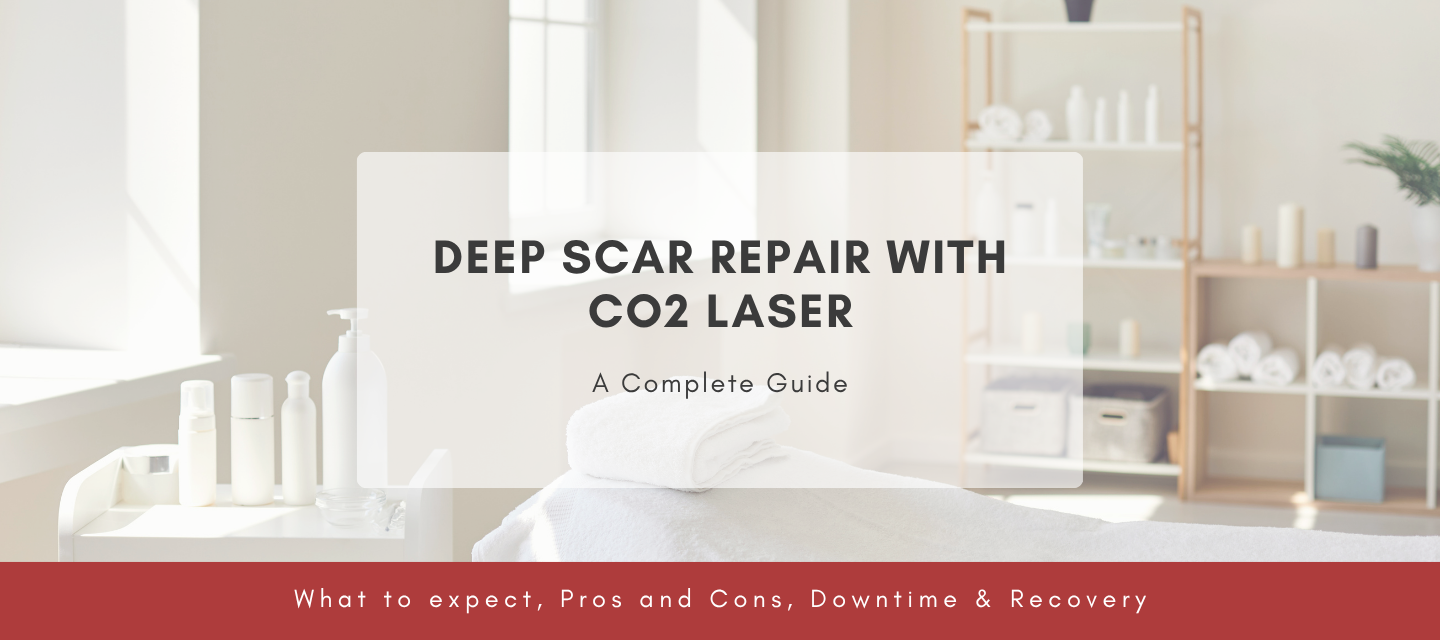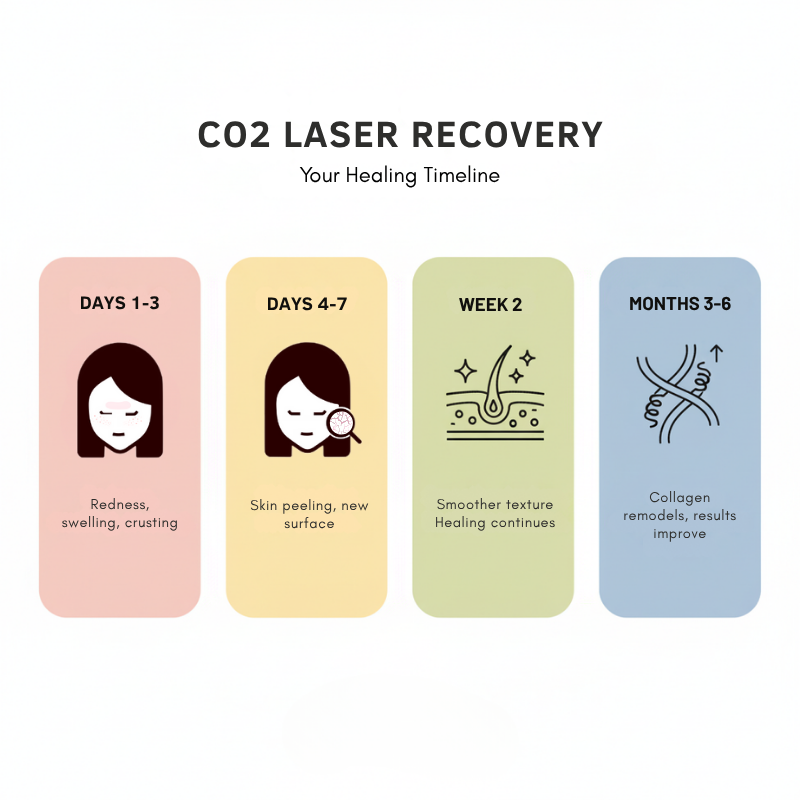
Deep Scar Repair with CO2 Laser: A Complete Guide
“The problem of acne scars is not simply a problem on the skin's surface, but is an important factor that has a profound impact on each patient's self-confidence and daily life.”
— Dr. Noh Hyo Jin, Director of My Future Dermatology Clinic
Living with acne scars is exhausting. Even after breakouts are long gone, uneven texture and dark marks often linger, making skin concerns feel never-ending. Many cosmetic treatments, such as chemical peels or superficial lasers, can help improve the surface, but usually don’t reach deep enough.
But for stubborn scars, CO2 laser resurfacing is the way to go.
Using concentrated laser light, this treatment reaches deeper layers, encourages new collagen fibers to form and smooths the treated area over time. Unlike quick fixes, fractional laser therapy targets the underlying damage while preserving surrounding skin, creating lasting results.
If you’re wondering whether it’s worth considering this treatment abroad, you might find this guide helpful: Should You Go to Korea for Acne Scar Treatment? An Atrophic Scar Guide.
What Is CO2 Fractional Laser?
A CO2 laser uses carbon dioxide laser technology to deliver precise beams of light into the skin. These beams gently vaporize thin layers of damaged tissue, remove the outer layer, and stimulate collagen production in the underlying skin. Result: smoother texture, reduced acne scarring, and overall facial rejuvenation.
The “fractional” part means the laser beam treats microscopic zones instead of the whole treatment area. Healthy surrounding tissue helps the treated skin heal faster, with less downtime compared to older ablative laser methods.
Compared to erbium lasers, or more superficial laser peels, CO2 fractional laser penetrates deeper, making it especially effective for stubborn acne scarring. As an added benefit, it can also improve concerns like deep wrinkles, sagging skin, and sun-damaged skin. By remodeling collagen fibers beneath the surface, it remains one of the most advanced forms of skin resurfacing and skin rejuvenation available today.
Weighing the Pros and Cons
Benefits of CO2 laser treatment:
✓ Reduced acne scarring and fine lines
✓ Smoother skin texture
✓ Improvement in enlarged pores
✓ Effective even on stubborn skin conditions like deep wrinkles and sun damage
Things to Keep in Mind
- Temporary redness, swelling, and a mild burning sensation
- Requires careful aftercare and avoiding heavy sun exposure
- Initial healing takes 5–7 days, though redness may last 2–3 weeks
- Certain dark skin types require careful evaluation due to the higher risk of PIH or post inflammatory hyperpigmentation.
Remember: While CO2 is a gold-standard ablative laser treatment, it’s not a one-session miracle. The healing process takes time, and realistic expectations should be considered.
Who Is It Best For?
CO2 laser skin resurfacing is recommended for:
- Acne scars (ice pick, boxcar, rolling)
- Sagging skin or mild skin laxity
- Deep wrinkles and rough texture
- Age spots and sun-damaged skin
It can also help with delicate areas, such as eyelid skin laxity, with proper precautions.
If you’re unsure whether your skin type is suitable, our AI skin analysis can give you a clearer picture of your concerns before committing to treatment.
However, not everyone is an ideal candidate…
Those with active acne, fungal infection, cold sores, or certain medical history conditions (like keloids) should avoid this procedure. People with darker skin color may need alternative cosmetic treatments, since the risk of pigmentation changes is higher. Always consult a dermatologist to determine if a fractional laser or ablative laser option suits your skin type and goals.
What to Expect During Treatment
A typical treatment session begins with a local anesthetic or numbing cream to minimize discomfort. For more extensive treatments, some clinics may offer light sedation, though general anesthesia is rarely needed.
The dermatologist uses a laser wand to deliver short pulses of laser light, targeting thin layers of damaged skin while leaving surrounding skin intact.
You might feel warmth, tingling, or a slight burning sensation. In some cases, an ice pack wrapped in a clean towel is applied afterward to reduce swelling. Sessions usually last 30–60 minutes, and since it’s an outpatient procedure, you can go home the same day.
For safe results, always choose a clinic led by board-certified professionals. Explore trusted options here: Lulu-Recommended Clinics.
Treatment Sessions
- Typical number of sessions: 1–3, spaced 6–8 weeks apart.
- Early results: Visible within 1–2 weeks, as collagen starts forming.
- Long-term results: Continue improving over 3–6 months as collagen remodels.
Remember: Scars and wrinkles can dramatically improve, but may not vanish completely. Results vary based on scar depth, skin type, and aftercare.

Downtime & Recovery
After a CO2 fractional laser session, your skin will go through several healing stages:
Days 1–3
Redness, swelling, and sometimes oozing or crusting. (Redness may linger for 2–3 weeks, depending on your skin.)
Days 4–7
Peeling begins as new skin surfaces. Avoid picking or scratching to prevent scarring.
Week 2
Skin looks smoother with improved texture as healing continues.
Aftercare essentials:
✓ Apply antibacterial ointment or petroleum jelly as advised.
✓ If prone to cold sores, your doctor may prescribe an antiviral.
✓ Avoid sun exposure completely until the skin heals; then apply sunscreen daily.
Be aware of possible post-inflammatory hyperpigmentation (PIH)—more common in darker skin tones, but it usually fades with proper care.
Is CO2 Laser Worth It?
The frustration of acne scars often comes from treatments that only scratch the surface—the CO2 laser goes deeper. It’s why many dermatologists consider it the gold standard for stubborn acne scars, deep wrinkles, and sun damage.
That said, it’s not a one-size-fits-all solution, and the right outcome depends on the right clinic. Always consult with a qualified dermatologist who can assess your skin type, medical history, and treatment goals. For those exploring options, our recommended clinics page is a helpful starting point for your research.
And if you prefer gentler options, don’t miss: 10 K-Beauty Skin Treatments for Your Short Trip to Korea.
FAQs:
1. How painful is the procedure?
Most describe the session as tolerable with numbing cream, but the first few days after treatment can feel like a bad sunburn with heat, tightness, and stinging. Discomfort usually improves within a week as the skin heals, especially with proper cooling, ointments, and gentle skincare.
2. Should I keep treated skin moist or let it crust?
Most dermatologists and patients recommend keeping the treated skin moist using ointments or petroleum jelly. Moist wound healing reduces discomfort, prevents thick scabbing, and supports smoother recovery. Letting skin dry out can cause more irritation, delayed healing, or even worsen scarring in sensitive or acne-prone skin.
3. Can CO2 laser be combined with other treatments?
Yes, it is often combined with subcision, dermal fillers, or fat grafting for better scar improvement. Combination therapy works especially well for deep or tethered scars. However, it requires a skilled dermatologist who can plan treatments carefully to reduce risks, downtime, and potential complications from aggressive procedures.
4. What are the possible risks of CO2 laser?
Temporary redness, swelling, and post-inflammatory hyperpigmentation are common. Rare but serious outcomes include prolonged redness, worsening scarring, or texture irregularities. Results also vary, and some scars may respond poorly. To reduce risks, it is crucial to choose an experienced dermatologist and follow all recommended aftercare instructions closely.
5. How should I prepare before CO2 laser treatment?
Preparation usually involves avoiding sun exposure, tanning, and harsh skincare products like retinoids or exfoliants for one to two weeks. Some doctors prescribe antiviral medication if you are prone to cold sores. Staying hydrated, moisturizing well, and discussing medical history with your dermatologist help ensure safer results.

